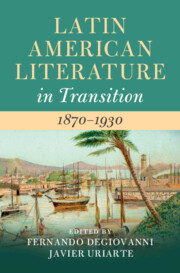Book contents
- Latin American Literature in Transition 1870–1930
- Latin American Literature in Transition
- Latin American Literature in Transition 1870–1930
- Copyright page
- Contents
- Figures
- Contributors
- Acknowledgments
- Introduction
- Part I Commodities
- Part II Networks
- Chapter 7 Latin Americanisms
- Chapter 8 Cosmopolitanisms
- Chapter 9 Chinoiseries
- Chapter 10 Diasporas
- Chapter 11 Feminisms
- Part III Uprisings
- Part IV Connectors
- Part V Cities
- Index
- References
Chapter 9 - Chinoiseries
from Part II - Networks
Published online by Cambridge University Press: 14 January 2023
- Latin American Literature in Transition 1870–1930
- Latin American Literature in Transition
- Latin American Literature in Transition 1870–1930
- Copyright page
- Contents
- Figures
- Contributors
- Acknowledgments
- Introduction
- Part I Commodities
- Part II Networks
- Chapter 7 Latin Americanisms
- Chapter 8 Cosmopolitanisms
- Chapter 9 Chinoiseries
- Chapter 10 Diasporas
- Chapter 11 Feminisms
- Part III Uprisings
- Part IV Connectors
- Part V Cities
- Index
- References
Summary
Even if the trend of chinoiseries reached its peak in the eighteenth century, in Latin America it persisted and gained new overtones through Modernismo. While in Europe this was a strictly foreign aesthetic found in Asian luxury exports and artifacts mass-produced for a consumer audience, in the Americas it became a racial phenomenon as well. Together with consumer goods, Chinese laborers started migrating to the region, complicating orientalist impressions of China imported from Europe. This chapter reexamines characterizations of Modernismo’s Asian imaginaries as a mere aesthetics of evasion, and instead reads them as a political critique of Chinese labor. While it acknowledges the prominence of the cultural politics of orientalism in the movement’s transcultural imaginaries of chinoiserie, it shows that the portrayal of the China trade opens a discussion on the global division of labor, nineteenth-century migrations, and the desire over foreign bodies.
Keywords
- Type
- Chapter
- Information
- Latin American Literature in Transition 1870–1930 , pp. 135 - 147Publisher: Cambridge University PressPrint publication year: 2022

